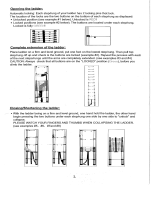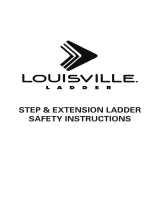Page is loading ...

Thank you for purchasing the Little Giant
Classic—the original multi-use ladder. When
used correctly, the Little Giant Classic is the
strongest, safest, most versatile ladder in the
world. Little Giant Ladder Systems subjects
each ladder to comprehensive tests for safety
in design and construction, so you can trust it
in all the work you do. In addition, the Classic
meets or exceeds stringent OSHA and ANSI
safety standards.
Please don’t ignore the instructions! Make
the most of your ladder system by learning
how to use it safely. If you have any questions
about how to operate your Little Giant
Classic, please call us. We value our
customers, and we’re happy to help.
Customer Service: 800-453-1192
Little Giant Ladder Systems
1198 N. Spring Creek Place
Springville, UT 84663
www.littlegiantladders.com
The Classic is made up of three major components: one inner
ladder assembly and two outer ladder assemblies that telescope
over the inner. The inner and outer assemblies work together with
the Triple-Locking hinge and the lock tabs to adjust the ladder into
different lengths and positions, including an A-frame stepladder, an
extension ladder, a staircase ladder, a 90-degree ladder, and trestles
for scaffolding. Each rung has slip-resistant treads, and each leg is
equipped with rubber feet for improved traction.
Inner and Outer Assemblies. When the ladder is in its storage
position, the inner assembly remains inside the outer assembly. To
raise the ladder’s height, simply telescope the inner assembly
upward and then lock it in place at the desired height using the lock
tabs on each side of the ladder. To lower the height again, telescope
the inner assembly back into the outer.
Triple-Locking Hinge. The Triple-Locking hinge is located at the
top of the ladder. The hinge unlocks so you can adjust the ladder
into different working positions. Understand how the Triple-Locking
hinge works by following the instructions listed on this manual to
adjust the ladder from its storage position and into a working
position.
Work Platform (optional). The versatile Work Platform fits on the
rungs of any Little Giant multi-use ladder and is rated to hold up to
300 lbs. Use it as a tray for a paint bucket or tools,
or use it as a sturdy, comfort-
able standing platform. Now
you can stand on your ladder
for extended periods without
sore feet and bruised shins,
and you can work with
both hands in any direc-
tion. (Do not stand on
the Platform above the
third rung from the
top.) The Work
Platform also serves
as a stabilizing
spreader bracket for
your Little Giant’s
trestle-and-plank
scaffolding
system.
USER INSTRUCTIONS

Thank you for purchasing the Little Giant Classic multi-use ladder. The
Classic is the original multi-use ladder, constructed to exacting standards
with the highest quality materials. Here is a quick reference guide to help
you get the most out of your ladder.
A-Frame
1. Unlock the Triple-Locking hinge. (see Figure 1)
2. Unlock the lock tabs. (see Figure 2)
3. Raise the inner ladder section to the desired height. (see Figure 3)
4. Align and engage the lock tabs in the rung holes. (see Figure 4)
5. Pull the two halves of the ladder apart until the hinges lock in the
A-frame position. (see Figure 5)
Extension
1. Unlock the Triple-Locking hinge. (see Figure 1)
2. Open the ladder to the extension position. (Figure 6)
3. Unlock the lock tabs. (see Figure 2)
4. Raise the upper half to the desired height. (see Figure 7)
5. Align and engage the lock tabs in the rung holes. (see Figure 4)
6. If necessary, raise the lower half for additional height. (see Figure 8)
Staircase / 90-Degree
1. Unlock the Triple-Locking hinges. (see Figure 1)
2. Unlock the lock tabs. (see Figure 2)
3. Raise the inner ladder section to your desired height. (see Figure 3)
4. Align and engage the lock tabs with the rung holes. (see Figure 4)
5. Pull the two halves of the ladder apart until the hinges lock in the A-frame
position. (see Figure 5)
6. Adjust one side of the ladder to the length needed to fit safely in your staircase.
(see Figure 9)
7. The 90-degree position is intended to bring the user of the ladder closer to a
work surface, without reaching to the side. The 90-degree position (where one
side is 1 foot shorter than the other and the ladder is placed on a level flat
surface) must only be used when back of the ladder is against a wall. (see
Figure 14)
Scaffolding
1. Unlock the Triple-Locking hinges. (see Figure 1)
2. Unlock the lock tabs. (see Figure 2)
3. Pull the inner ladder assembly completely out of the outer ladder sections. (see
Figure 10)
4. Open the inner ladder assembly to form the first trestle. (see Figure 11)
5. Turn one outer assembly around so both are facing the same direction (see
Figure 12) and lock them together using the lock tabs on nearest outer
assembly.
6. For extra stability, insert the Little Giant Work Platform in the second rung of
the outer assembly and push it down to lock it in place and to secure the
trestle. (see Figure 13)
7. Place an appropriate scaffolding plank at 3 feet or lower for scaffolding. (see
Figure 13)
Work Platform
If you purchased a Work Platform for your Little Giant Classic,
you can use it as an additional tool tray or standing platform.
1. Place the Work Platform’s hooks on the rung below your
desired platform height. (see Figure 15)
2. Place the Work Platform at the desired platform height.
(see Figure 16)
3. Push Work Platform forward; step directly on the platform.
(see Figure 17)
4. Climb to the rung above the platform and push the platform
into position with your toe. (see Figure 18)
5. Ensure the platform is secure and step onto the Work
Platform. (see Figure 19)
6. When finished, step to the rung above and push the platform
forward with the toe of your shoe and carefully step down
through the platform. (see Figures 20 and 21)
7. To store the Work Platform, open the ladder slightly and
hang the platform inside the ladder on the second rung from
the bottom. (see Figures 22 and 23).
1
22 232120191817 161514
2 3
A-Frame
Work Platform90º Work Platform Storage
Extension Staircase Scaffolding
4 5 6 7 8 9 10 11 12 13
Need Help? Visit www.littlegiantladders.com or call Customer Care at 800-453-1192.
©2009 Little Giant Ladder Systems 52000.2.10

Classic Operating Safety Tips
1. Little Giant Ladder Systems assumes no liability for
damage or injury that may result from failing to follow all
instructions correctly.
2. The Classic has an ANSI duty rating of 300 pounds. For
your safety, do not exceed the weight limit. Follow other
safety tips listed on your ladder.
3. Read all labels on the ladder before use.
4. Always hold the ladder with both hands on the vertical
upper rails or hinges while telescoping the inner ladder up or
down.
5. Make sure each of the four lock tabs is fully engaged into
the rung holes before climbing on the ladder. Failure to do
so may result injury.
6. Hinge lock must be fully engaged before using. Failure to do
so may result in injury.
7. Do not open the lock tabs without first securing the inner
ladder assembly to prevent it from sliding down rapidly.
8. Use caution when using the ladder around electricity.
Ensure that the ladder does not come in contact with
electrical circuits or currents.
9. Keep clothing and body parts out of working, moving
mechanisms, including the Triple-Locking hinge and the lock
tabs to avoid pinching.
10. Do not stand above the third rung from top.
11. Keep all ladd
er rungs, ladder feet, work platforms, and
other standing and gripping surfaces clean and free from
foreign materials.
12. Make certain the Work Platform is secure before standing
on it.
13. Do not force the hinges in or out using any tools. You may
cause permanent damage to the hinge mechanism.
14. If there is pressure on the hinge lock pins, they may not
open properly. Relieve the pressure by moving one half of
the ladder back and forth until the hinge locks move with
minimal force.
GENERAL OPERATING SAFETY TIPS
Register Your Warranty
The Little Giant Classic comes with a limited lifetime warranty against manufacturer defects. For
detailed information on the Little Giant Classic Warranty, please visit www.LittleGiantLadders.com.
It only takes a moment to protect your investment for a long time, so don’t forget to register your
Classic warranty through one of three methods:
1. Go online at www.LittleGiantLadders.com.
2. Call Little Giant Ladder Systems at 800-453-1192.
3. Return the Little Giant Ladder Systems warranty card by mail.
15. Use the proper angle for the extension ladder position. The
distance from the base of the ladder to the bottom of the
support wall should be one quarter the working height of the
extension ladder, with a minimum of three horizontal feet.
16. Do not allow the full weight of the ladder to fall on the
hinges as the ladder folds from the extension to the A-frame
position (see Figure 4).
17. For your safety, the rungs should always be level from front
to back and from side to side.
18. Do not use outer or inner sections of the ladder as a
separate stepladder.
General Ladder Safety Tips
1. Select the correct ladder for your job—a ladder that is both
rated for your weight and designed for the appropriate height
and type of work you’re doing. For example, if you’re cleaning
out gutters, you may need a tall ladder, not a stepladder.
2. Do a basic safety check before you get on any ladder. Look it
over and make sure that rivets and welds are tight and in
good condition, that rails are in place, and that the ladder
doesn’t wobble unsafely. Check the feet of the ladder to make
sure there’s no build up of dirt, oil, or other material that
would create an uneven surface.
3. Face forward and climb one rung at a time while going up or
down a ladder.
4. Don’t stand on either of the top two rungs of any kind of
ladder.
5. If there are multiple ladders set up against a building, don’t
step from one ladder to the next. Climb down the ladder
you’re on and before going up the next.
6. When you’re on a ladder, don’t lean or reach far to one side; a
good rule of thumb is to always keep your belt buckle
between the side rails. It’s better to be safe and come down
from the ladder and move it closer to your work area than to
reach too far and cause the ladder to fall.
/









